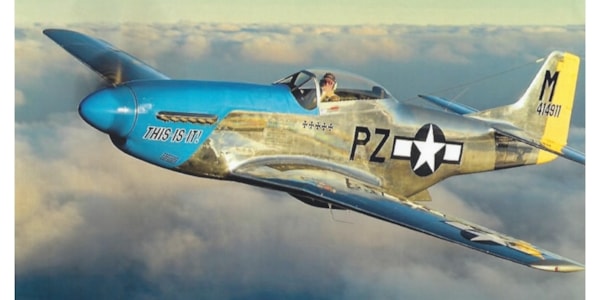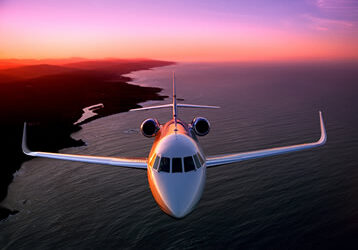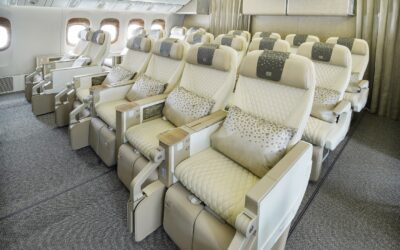P-51 Mustang up for auction in January

The North American P-51 Mustang, an American long-range fighter bomber with a long history, is up for auction next month. The plane is listed on GlobalAir.com and will be auctioned online next month.
This 1944 P-51D was painted in January 2011 and complete logs are available. The plane only has 920 TT and the starting bid is $250,000. The online auction is presented by Aircraft bidder and will run from Jan. 23, 2023, through Jan. 31, 2023.
The P-51 Mustang start and WWII use
The P-51 was used during WWII and the Korean War after its introduction in January 1942. The plane was designed in April 1940 by a team under James H. Kindelberger of North American Aviation following a requirement from the British Purchasing Commission. NAA was approached to build Curtiss Warhawk P-40 fighters under license for the Royal Air Force and decided to build a more modern fighter instead.
The prototype was sent out on Sep. 9, 1940, and the first flew on Oct. 26 that year. The P-51 Mustang was designed with the Allison V-1710 engine and then replaced by a Rolls-Royce Merlin after the original engine prevented high-altitude performance for the aircraft. The new P-51B/C (Mustang Mk III) model allowed the plane to fly at altitudes above 15,000 ft without sacrificing range. The new engine allowed the P-51 to compete with Luftwaffe’s fighters.
The P-51D was powered by the Packard V-1650-7, another version of the Rolls-Royce Merlin. The license-built version of the Merlin 66 was a two-speed, two-stage-supercharged engine with six .50 caliber AN/M2 Browning machine guns. From 1943 on, versions like the P-51B, P-51C and P-51D were used by the USAAF Eighth Air Force to escort bomber raids over Germany. The RAF Second Tactical Air Force and the USAAF Ninth Air Force also used the planes as fighter bombers. WWII Mustang pilots claimed to have destroyed 4,950 enemy aircraft.

P-51 after WWII
Following success in WWII, the USAAF consolidated many of its aircraft used for combat force and chose the P-51 as the standard for a piston-engined fighter. By 1947, the USAF Strategic Air Command used the plane alongside F-6 Mustangs and F-82 Mustangs. In 1948, the P for pursuit was changed to F for fighter, changing the P-51 to an F-51.
The plane stayed in service through the early 50s and variations like the P-51D (F-51D) were used in the combat zone during the Korean War. The long-range capability of the aircraft made them popular for combat over short-range F-80 jets. The fleet suffered a substantial loss due to ground fire because of the vulnerable liquid cooling system in the plane.
These Mustangs continued use for the USAF and ROKAF fighter-bomber units on missions in Korea until about 1953 when they were replaced by USAF F-84s and USN Grumman F9F Panthers.
The Air Force Reserve continued flying P-51s in the 50s and the last was retired to the Air Force Central Museum in January 1957. The last sent to retirement was reactivated for flight for the 50th anniversary of the Air Force Aerial Firepower Demonstration at the Air Proving Ground at the Eglin Air Force Base in Florida on May 6, 1957. It is now on display at the National Museum of the United States Air Force in Dayton, Ohio.
As the plane was withdrawn from military use, many hit the market for civilian use. Rights to the plane were purchased from NAA by Cavalier Aircraft Corporation, which then marketed the plane in the U.S. and overseas. In 1967 and 1972, USAF remanufactured some P-51s from Cavalier, many designated to air forces overseas. Many were refitted with new engines, new radios and a second seat behind the pilot.

The final military use for the plane was in 1968 when the army employed the plane as a chase aircraft for a Lockheed YAH-56 Cheyenne armed helicopter project. After the success of this project, two more were purchased from Cavalier for use as chase planes. They were refit and used for other projects. One is on display at the Air Force Armament Museum at Eglin Air Force Base in Florida.
Many foreign air forces used the fighter through the mid-1980s. The last to be downed in battle was during Operation Power Pack in 1965 n the Dominica Republic. The last was retired by the Dominican Air Force in 1984.
The P-51 Mustang and variations served over 25 nations in the air.

P-51 after the military and civil aviation use
After the planes mostly fell out of military use, many were sold for personal use and some were modified for air racing.
Film stunt pilot Paul Mantz modified the wings, sealing them to create a giant fuel tank in each, reducing the need for a fuel stop. The modified plane was nicknamed the Blaze of Noon and won the 1946 and 1947 Bendix Air Races, took second in 1948 and third in 1949. He set a coast-to-coast record in 1947 and eventually sold the plane to Charles F. Blair Jr.
Blair renamed the plane Excalibur III and set a New York-to-London record in 1951, with a seven-hour and 48-minute flight from takeoff. He also flew from Norway to Fairbanks, Alaska through the North Pole, which proved that navigation using sun sights was possible, even over the North Pole region. He was awarded the Harmon Trophy and the plane now sits in the National Air and Space Museum Steven F. Udvar-Hazy Center.
The remaining 78 mustangs owned by the RCAF were retired in 1958 and then ferried to storage locations in New York for buyers. These mustangs make up the majority of the P-51s flying in the world today.
Today, a P-51 in any condition is a prized find. In 2011, there were 204 privately owned P-51s in the U.S. on the FAA registry, some associated with the CAF.
The iconic plane up for auction has a blue nose and the remainder of the aircraft is polished with warbird markings. The interior features a green and black cockpit, khaki seats and wood flooring.

Don’t miss this opportunity to own a piece of aviation history.
Check out the listing on GlobalAir.com HERE.
See more photos and details HERE.
Contact
Name: Haley Davoren
, Digital Content Manager
Company: GlobalAir.com
Website: http://globalair.com
Email: [email protected]
Phone: 502-456-3934
©2022 GlobalAir.com, Haley Davoren. All rights reserved.



Recent Comments